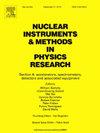Monte Carlo simulations towards the formation of a positronium coherent beam
IF 1.5
3区 物理与天体物理
Q3 INSTRUMENTS & INSTRUMENTATION
Nuclear Instruments & Methods in Physics Research Section A-accelerators Spectrometers Detectors and Associated Equipment
Pub Date : 2024-11-18
DOI:10.1016/j.nima.2024.170068
引用次数: 0
Abstract
Positronium (Ps) has emerged as a promising test particle within the QUantum interferometry with Positrons, positronium and LASers (QUPLAS) project, which aims to measure for the first time the gravitational effect on Ps, the entirely leptonic atom comprising an electron and a positron. In this work, we present a Monte Carlo simulation to generate a mono-energetic and highly coherent Ps beam by creating a negative Ps ion (Ps consisting of two electrons and one positron) to be used in a Mach–Zehnder interferometer. We propose the equations to estimate the initial velocity distributions in the longitudinal and transversal directions of the Ps emitted from the target converter (positron/Ps) necessary for the Monte Carlo simulation. The resulting simulated device needs a very low divergence Ps beam at the interferometer entrance, for this reason an intensive positron beam is necessary, such as a high-flux electron LINAC. Subsequently, we utilize a Fabry–Perot IR laser cavity operating in CW at a wavelength of 1560 nm to selectively remove the extra electron. An alternative pulsed laser operating at a 3600 nm wavelength was studied to reduce broadening due to recoil and excitation. Here, we provide a Monte Carlo simulation to estimate the characteristics of the Ps beam, including its energy distribution and intensity profiles at two different temperatures (10 K and 300 K). Despite the limitations given by the assumptions mentioned in the text within the limit of our knowledge, these first simulation results obtained from our study will provide essential groundwork for future advancements in fundamental particles gravity measurements.
蒙特卡洛模拟正电子相干束的形成
正电子(Ps)已成为 "正电子、正电子和激光器量子干涉测量"(QUPLAS)项目中一种很有前途的测试粒子,该项目旨在首次测量 Ps(一种完全由电子和正电子组成的轻子原子)的引力效应。在这项工作中,我们提出了一种蒙特卡洛模拟,通过创建一个负 Ps 离子(Ps- 由两个电子和一个正电子组成)来产生单能量和高相干的 Ps 光束,并将其用于马赫-泽恩德干涉仪。我们提出了蒙特卡罗模拟所需的方程,用于估算从目标转换器(正电子/Ps-)发射的 Ps- 在纵向和横向的初始速度分布。由此产生的模拟装置在干涉仪入口处需要非常低发散的 Ps 光束,因此需要密集的正电子光束,例如高通量电子 LINAC。随后,我们利用一个波长为 1560 纳米的法布里-珀罗红外激光腔,以连续波工作方式选择性地去除多余的电子。我们还研究了另一种波长为 3600 nm 的脉冲激光器,以减少反冲和激发引起的展宽。在此,我们提供了蒙特卡洛模拟来估算 Ps 光束的特性,包括其在两种不同温度(10 K 和 300 K)下的能量分布和强度曲线。尽管文中提到的假设在我们的知识范围内有一定的局限性,但我们的研究获得的这些首次模拟结果将为未来基本粒子引力测量的进步提供重要的基础。
本文章由计算机程序翻译,如有差异,请以英文原文为准。
求助全文
约1分钟内获得全文
求助全文
来源期刊
CiteScore
3.20
自引率
21.40%
发文量
787
审稿时长
1 months
期刊介绍:
Section A of Nuclear Instruments and Methods in Physics Research publishes papers on design, manufacturing and performance of scientific instruments with an emphasis on large scale facilities. This includes the development of particle accelerators, ion sources, beam transport systems and target arrangements as well as the use of secondary phenomena such as synchrotron radiation and free electron lasers. It also includes all types of instrumentation for the detection and spectrometry of radiations from high energy processes and nuclear decays, as well as instrumentation for experiments at nuclear reactors. Specialized electronics for nuclear and other types of spectrometry as well as computerization of measurements and control systems in this area also find their place in the A section.
Theoretical as well as experimental papers are accepted.

 求助内容:
求助内容: 应助结果提醒方式:
应助结果提醒方式:


